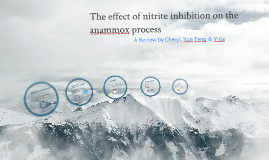Review Template 3
Transcript: Structured - narrative and diagram; Clear focus & Specific scope; Comprehensive Analysis of factors; Succinct presentation of information; Clear direction for future studies Made Assumptions and failed to provide detailed background info; Less cautious in certain aspects; Some Arguments ungrounded: partly due to bad presentation of style; partly due to arbitrary statements; Some Arguments too narrow/exclusive Thank you. Theoretical understanding of chosen methodology is not provided Reason for chosen methodology is not provided “results showed a high accuracy of the measurement” Activity can be fully recovered by decreasing nitrite concentration after exposure to 1g N/L for 24 h, “confirming the results obtained by Kimura (2010)” Brief explanation of process Nitrite + Ammonium are converted to nitrogen gas in the absence of oxygen (Canziani, 2010) History of R_NiAm and R_NaAm and how it could look like Shift in focus as compared to other researchers From only studying the levels at which negative effect of nitrite would occur, to determining if effect is inhibitory or toxic Commendable move because the scope is widened, providing a clearer picture for researchers The negative effect of nitrite on anammox activity is reversible, i.e. inhibitory, rather than irreversible, i.e. toxic For introducing the anammox process Linking the theory with the practical rationale for the experiment Ground & Ceiling The recovery from nitrite inhibition during an exposure of up to 24 hours, this is against the conclusion in Egli’s paper about reactor failure Inhibition of anammox conversion due to nitrite Mode of action of nitrite “the method applied avoided any disturbances of the process during the batch measurement” Novelty of idea Clarity of presentation of purpose of experiment Scope of research Shortcomings Author explained after almost every instruction given. Idea is not new Anammox technology to treat wastewater with high ammonium content Cost effective Easily employed Designing wastewater plant Clarity of Presentation of Idea/Problem At what levels would the negative effect of nitrite occur? Is effect inhibitory or toxic? Anammox activity recovery behaviour - complete recovery? Reproducibility of Experiment Novelty of Idea Graph without A Table Conclusion Dominant anammox bacteria in a lab-scale enrichment can either be Brocadia or Kuenenia (Van der Star, 2008) Reproducibility of experiment hinges on determination of bacteria - True values are unknown, this statement is overconfident. Results Observation A Simple Visualization to Show the Relationship A.C. Anthonisen, 1976 The effect of nitrite inhibition on the anammox process Ammonium and nitrite; Ammonium and nitrite in an aerobic environment; Nitrite only; Effect of pH The Good Exposure tests Inadequate Employment of Visual aid Anammox activity recovered completely after exposure to certain level of nitrite, nitrite and ammonium, and to oxygen during nitrite incubation Theoretical understanding of the chosen methodology was not provided. Reason for chosen methodology was not provided many inhibition mechanisms for Free Nitrous Acid, not sufficient to use one mechanism to explain the inhibition The Bad Clear structure Good combination of literature Can solve the problems brought up in introduction Convincing generally Something about Percentage Discussion Enabled deeper comprehension of procedure Data analysis Assessment of Introduction - Shortcomings Introduction Not always reproducible. W. R. L., 2007 Did not show what results Kimura got, confusing Percentage that you could probably read from the graph Strous et al., 1998 Suitability and accuracy Purpose of experiment is clearly stated Assessment of Methodology - Shortcomings Assessment of Methodology - Strengths Long term recovery of anammox activity after nitrite exposure Style & Uncertainty Origin of samples for experiment Reasonable experimental conditions Rationale for procedure - 550 mg N/L first then changed to 860 mg N/L for 7 days and then changed to 540 mg N/L Nice juxtaposition Uncertainty Rationale for selecting this topic Purpose of experiment Utility of Manometric batch tests, including preliminary tests using varying levels of biomass samples with varying pH, ammonium and nitrite levels, exposure durations and conditions. Generally good! Rationale for Methodology not given - Too absolute and no evidence provided. Percentage you could probably never read or even found from the paper Reproducibility of Experiment Manometry is a convenient and simple technique of measuring the pressure variation due to a gas production or consumption caused by biochemical reactions or physical changes. ***Useful for poorly soluble gases - such as Nitrogen The activity can be recovered after long time exposure in high nitrite concentration if low nitrite concentration is provided after that, however the activity cannot be fully recovered Employment of visual aids Providing rationale for methodology The reactor

















